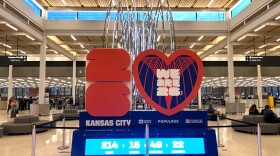
This is the first of a three-part series that examines issues of racial injustice in an often overlooked place: rural Kansas.
Click here to read the second part about discrimination against Black farmers in northwest Kansas and here to read the third part about the struggle to elect Latina candidates in southwest Kansas.
HAYS, Kansas — On the night of Jan. 6, 1869, Luke Barnes, Lee Watkins and James Ponder sat in jail accused of shooting a white railroad worker in this northwest Kansas town.
By sunrise, the three Black men had been dragged from their cell by a mob of white townspeople and hanged from a railroad trestle over the creek that separates the town from Fort Hays, where the men were stationed in the U.S. Army. A Leavenworth newspaper reported that the town “indulged them in a dance in mid-air.”

One hundred and twenty years later — in 1989 — the county commission gave a five-mile stretch of road near that bridge a new name drawn from that ugly history: Noose Road.
“The lynching at the bridge was just one episode in a long story of bad blood,” said historian Jim Leiker, who grew up in Hays and now teaches at Johnson County Community College. “It kind of left a mark on Hays’ early history of race relations that never quite went away.”
The two events — the 1869 lynching and the 1989 naming of Noose Road — represent a small glimpse into an uncomfortable history of racism that lingers today.
Kansans sometimes romanticize the Bleeding Kansas days and abolitionist John Brown’s raids in the fight to determine whether the state would join the union with or without slavery. But that “free state” pride tends to paper over brutally racist parts of Kansas history. To be sure, white supremacy was not as openly embraced here as in the Deep South, but Kansas has at times been violently, even murderously, unwelcoming to African Americans.
Leiker, who is white, has had ancestors in this area since the 1870s.
“Growing up in Hays, I heard the old-timers tell stories about how this was a Jim Crow town, how Blacks were not allowed to stay overnight here. It was a sundown town,” Leiker said. “So there was always that legacy that kind of hung over the town going back to the lynching.”

In the late 1860s and early 1870s, most of the men stationed at Fort Hays were Black, part of a group known as the Buffalo Soldiers. The newly formed wild west town of Hays City, which was predominately white, sat about a mile north of the fort on the other side of Big Creek.
“It was just a recipe,” Leiker said, “for a lot of chaos.”
By the end of the Civil War, roughly 180,000 Black soldiers, about half of them formerly enslaved themselves, had joined the Union Army in the hope of winning their freedom. The ones who continued to serve after the war were often sent to frontier outposts like Fort Hays, Fort Larned south of Great Bend and Fort Wallace near the Kansas-Colorado border. In the late 1860s, race riots broke out in the areas surrounding each of those military bases, according to historian Brent M.S. Campney’s 2015 book, This Is Not Dixie.
“The presence of Black soldiers,” said Ashleigh Lawrence-Sanders, who teaches African-American history at the University of Dayton in Ohio, “is always seen as a danger to a white community.”
Sundown town
In the first half of 1869 alone, lynchings and riots in Hays claimed 11 Black lives, again, as compiled by Campney. During the town’s largest race riot that year, six Black soldiers were killed. The Omaha World-Herald reported that their bodies were “thrown into a well, which by the next morning was sodded over and apparently never existed.”
But the racist violence in Hays wasn’t only directed at the African Americans in uniform.
During a May 1869 riot, a mob lynched two of the town’s barbers. Two years later, a woman was allegedly raped in her Hays home by a group of four white men. That incident sparked another riot that took one more life. Campney wrote in “This Is Not Dixie” that both the 1869 and 1871 Hays riots ended up effectively driving any remaining Black civilians from town.
Lawrence-Sanders said the violence came with a purpose.
“They wanted to continue to maintain the boundaries of their space as white spaces,” said Lawrence-Sanders. “Violence was a way of enacting those boundaries.”

In the decades following the Civil War, hundreds of towns across the Midwest — including Hays, Ness City and Liberal in western Kansas — used violence and threats to prevent Black Americans from living or visiting there.
They became known as sundown towns because it was dangerous for African Americans to be seen there after dark. Many of the towns did not have official anti-Black laws, but the towns stayed white.
Between 1867 and 1912, lynchings, threatened lynchings and other forms of mob violence terrorized African Americans across the Kansas frontier — from Hoisington in the central part of the state to Hugoton in the southwestern corner.
A crowd of 50 Kansans pulled George Mack behind a horse before hanging him in Great Bend. Campney wrote that the "mob dragged him for nearly a mile." An estimated 500 people descended on Larned from four surrounding counties to lynch Hugh Henry. In Hodgeman County north of Dodge City, a group of ten men tarred and feathered a Black settler.
“Black people may not have been alive when this lynching happened,” Lawrence-Sanders said, “but the memory of that violence persisted into these communities that a perception still stands of Hays and other surrounding communities that this is not a place for Black people at all.”

Noose Road
Hays attorney John T. Bird grew up on his family’s farm on Noose Road, before it was named that, and moved back there just over a year ago. He said he was so ashamed of his new address that he used a post office box in town for his mail.
When the road’s name sparked social media controversy following George Floyd’s death last May, the debate spilled over into a county commission meeting.
Bird wrote a letter to the commissioners and spoke in favor of changing the road’s name at the meeting. He knew the lawmakers who named it back in 1989, and he regrets not pushing back sooner.
“Frankly, I’m at fault as much as anybody for not speaking up,” said Bird. “I should have raised hell then, and I didn’t.”

After debating the issue last June, the commission voted unanimously to change the road’s name. It’s now called Rome Road. But the damage from decades of racist violence in Hays had already been done.
When Bird went to law school in Topeka in 1968, his African-American roommate refused to join him on a trip back to Hays.
“And I said, ‘Why?’,” Bird recalled. “He says, ‘Well, they hang Black people out there.’”
Free but not welcome
Hays isn’t the only place in Kansas that has been publicly debating its racist past in recent months. There’s the Topeka school district named after a Ku Klux Klan leader, Negro Creek in Johnson County, and downtown Wichita’s Civil War memorial that honors Confederate dead.
But how did all of this happen in a free state that shows up in textbooks on the right side of Civil War history?
“Kansas wanted to be a free state so they could rid the state of all Black folks,” said Carmaletta Williams, executive director of the Black Archives of Mid-America in Kansas City, “They didn’t want any free or enslaved within its boundaries.”

To be clear, abolitionists fought for the freedom of African Americans in the Bleeding Kansas battles leading up to the Civil War. But most of the northern settlers who migrated to Kansas during that time were Free-Soilers who wanted land to go to white homesteaders, not plantations. In December of 1855, supporters of the anti-slavery Free-State Party ratified Kansas’s first constitution and voted 1,287 to 453 to also ban free Black people from the territory. When Kansas finally became a state around five years later, the slavery ban stuck, but the new constitution allowed African Americans to settle in the state.
Williams draws a connection between America’s failure to reckon with racist violence of its past and the ways that racism persists today.
“We can always say, ‘That was in the past, let’s forget it, let’s move on,’” Williams said. “But you can’t move on until you address it and confront it and deal with it.”
She partners with the Community Remembrance Project to bring multicultural communities together at lynching sites to memorialize the victims and discuss what racial justice looks like locally. Jars of soil are collected from the sites and displayed at museums across the county, including Kansas City’s Black Archives.
“Just don’t ignore it,” Williams said. “Just don’t say it didn’t happen.”

‘We are growing weary’
Today, Hays is a town of about 21,000 people — roughly 88% white and 1% Black. For those who belong to that tiny minority, advocating for racial equity can feel overwhelming.
“It’s not going to happen overnight,” said Nuchelle Chance, who moved here from North Carolina in 2018. “And, honestly, people like myself … we are growing weary.”

She teaches psychology at Fort Hays State University and lives in Hays with her husband, Demetrius, and their five kids. As the faculty advisor for FHSU’s Black Student Union, she’s heard numerous stories from students of color who end up leaving Hays after facing racial hostility.
When she’s spoken up about racism on social media, she’s received death threats. Her husband has been the target of racial slurs and profiling. Their 9-year-old son was called the n-word while playing with neighborhood kids.
“That is still indicative of the energy that supported sundown towns,” she said.
Demetrius Chance, a community advocate, said that when people are marginalized for so many years, it can be hard for them to feel like things in their town can ever change. They may decide that it’s not worth it to risk attack for speaking up.

“Hays is a nice place,” he said. “But, yes, when it comes to being vocal about racism or about these issues, nobody wants to talk about it.”
So last fall, the Chances formed a local group that provides space for people of color to talk about their experiences. Around the time of the Noose Road debate, they helped organize the town’s Black Lives Matter protests.
Despite the risks, Demetrius Chance said he’s not afraid to be the one to start that conversation about what life really looks like for African Americans in Hays.
“I told them I will be that voice, I will put that target on my back,” he said. “It’s not to bad mouth this town, it’s not to talk bad about people. This is pure reality. … It’s just not whitewashed.”
David Condos covers western Kansas for High Plains Public Radio and the Kansas News Service. You can follow him on Twitter @davidcondos.
The Kansas News Service is a collaboration of High Plains Public Radio, Kansas Public Radio, KCUR and KMUW focused on health, the social determinants of health and their connection to public policy. Kansas News Service stories and photos may be republished by news media at no cost with proper attribution and a link to ksnewsservice.org.








